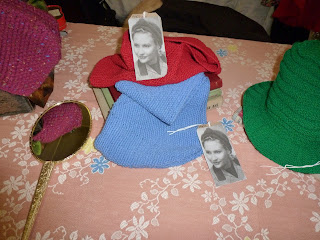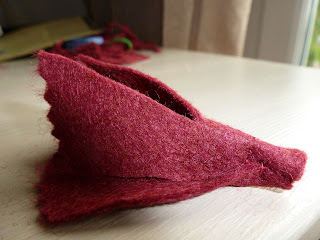At present, I make what I love to sell at vintage fairs and I also knit to order. It is wonderful to see the old patterns come to life and I thought you may like to see them too. My mum also enjoys making from vintage patterns so some of the items are made by her, especially the crocheted ones.
On Sunday I had a stall at Halifax Vintage Extravaganza. The following pictures are of items I had there.
 |
| You might recognise these from my previous post. They make a gorgeous colourful bouquet. Displayed in a cut glass dish from a charity shop. |
 |
| The stall in full. Notice I have used a carnation as an accessory and to hide my belt buckle! |
 |
| A 1950's petal cap. Each petal is knitted individually then sewn together. It is worn towards the back of the head and pinned in place. |
 |
| The green pom pom hat, you can see it is in the original colourway. From the 1940s. Best worn at a jaunty angle. Handmade by my mum! |
 |
| 1940's moss stitch turbans. There is a cap part that sits at the back of the head. The long strand is then twisted to form a knot and looped over the cap to secure it. |
 |
| A 1940's leaf beaded leaf band and matching beaded bag. In cream, it would suit a vintage bride. Handmade by my mum. |
 |
| Several leaf bands and a gorgeous beaded snood. The cabled scarf is a 1940's lady's cravat. The gold hat is a 1950's Juliet cap. |
 |
| A 1940's cable edge cap. Also to be worn at a jaunty angle. Lined with vintage Chinese brocade from my great auntie's curtains! Handmade by my mum. |






















